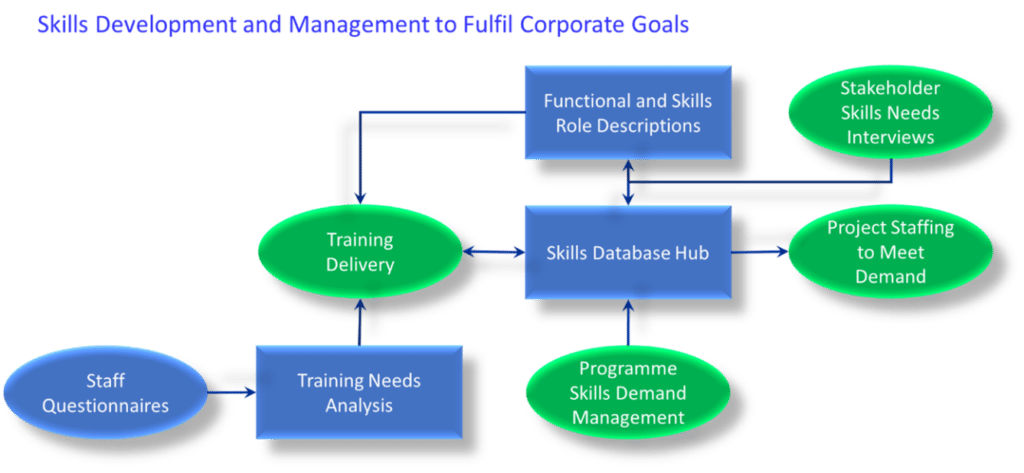The question of who to train and when is one that every organisation faces. As technology evolves rapidly and business demands shift, ensuring that your workforce has the right blend of skills and competencies has never been more critical.
However, many companies ask only half the question. It is not just about who to train, but also how to blend and develop skills strategically to maximise flexibility, performance, and long-term capability.
Employers today must build teams with multiple skill sets. The era of lifelong single-specialisation roles has passed. Instead, a focus on developing primary, secondary, and even tertiary skills can help businesses stay agile, competitive, and resilient.
This article explores how to identify, train, and manage skills within your workforce, with insights on how TSG Training can help you close skills gaps through targeted business and IT training courses.
Why Building a Skills Database Is Essential
A well-designed skills database is one of the most powerful tools an organisation can have. It allows you to record, monitor, and manage every employee’s skills, experience, and availability.
Such a database helps you answer critical questions such as:
Can we meet the skills demand profile for upcoming projects?
Which employees can be trained in time to fill gaps?
What new training initiatives are needed, and when?
Should we hire new staff or train existing employees?
By managing this data effectively, you can make informed decisions on staffing, training, and recruitment.
Identifying What Skills Are Needed
The first step in any workforce development plan is to understand what skills are required to deliver your business objectives. When assessing your needs, consider:
Project requirements and timelines
Emerging technologies or methodologies
Cross-functional collaboration needs
Leadership and communication skills
For example, if you are delivering a complex IT transformation, you may need individuals skilled in software testing, project management, and business analysis.
You can explore accredited programmes such as the BCS Foundation Certificate in Business Analysis or the ISTQB Certified Tester Foundation Level course to ensure your teams have the technical and analytical expertise needed for success.
Creating and Maintaining Functional Role Descriptions
Alongside identifying skills, maintaining accurate role descriptions ensures that the right people are assigned to the right roles.
For example, the term “performance skills” might refer to very different roles:
A Performance Strategist who designs system architecture.
A Performance Modeler who analyses data patterns and transactions.
A Performance Engineer who uses tools to verify system performance.
Each of these roles requires distinct skills and levels of expertise. Keeping role descriptions updated helps clarify responsibilities and supports accurate resource planning.
The Importance of Training Needs Analysis
A Training Needs Analysis (TNA) provides a structured approach to workforce development. It helps organisations identify gaps between current skills and future business requirements.
A comprehensive TNA should include:
A full list of skills and competencies required
An assessment of current employee skill levels
An understanding of individual career aspirations
A gap analysis to inform hiring or training plans
Once completed, the TNA serves as a roadmap for targeted training initiatives. It ensures that investments in professional development align with business objectives and timelines.
TSG Training’s business analysis and software testing courses are designed to complement TNA outcomes by addressing real-world skill gaps in IT and digital transformation.
Engaging Stakeholders in Skills Development
Stakeholders play a vital role in defining the skills needed for success. They understand the specific requirements of their departments and projects.
Engage stakeholders through interviews, surveys, or collaborative workshops to identify:
Current skills being used
Anticipated future needs
Gaps affecting performance or delivery
Combining stakeholder insights with employee data will provide a holistic view of your organisation’s capabilities.
Capturing Employee Skills and Ambitions
Many employees possess hidden skills that managers may not be aware of. Encourage staff to self-report their expertise through questionnaires or digital profiles.
This not only uncovers untapped potential but also boosts morale and engagement. Employees who see their skills recognised are more motivated to develop further.
TSG Training supports this process through flexible online learning and corporate training solutions designed to help organisations upskill at scale.
Project and Skills Demand Management
Effective demand management means anticipating what skills will be needed, not just reacting to immediate project requirements.
Project managers should consider:
Which skills and experience are required
When they are needed and for how long
Whether current staff can meet the need or require training
Early identification of skills demand allows enough time to train or rotate existing employees rather than relying on external hiring.
Maintaining Your Skills Database
A skills database is only as good as the data it contains. Continuous maintenance is essential to ensure accuracy and relevance.
It should answer vital questions such as:
What skills do we currently have, and where?
What training is required to fill upcoming gaps?
When should we hire or retrain?
Which skills are becoming redundant and can be repurposed?
Regular updates turn your database into a strategic asset that improves workforce planning and reduces turnover.
To support this process, consider developing an ongoing partnership with TSG Training to ensure continuous learning and development across your organisation.

















